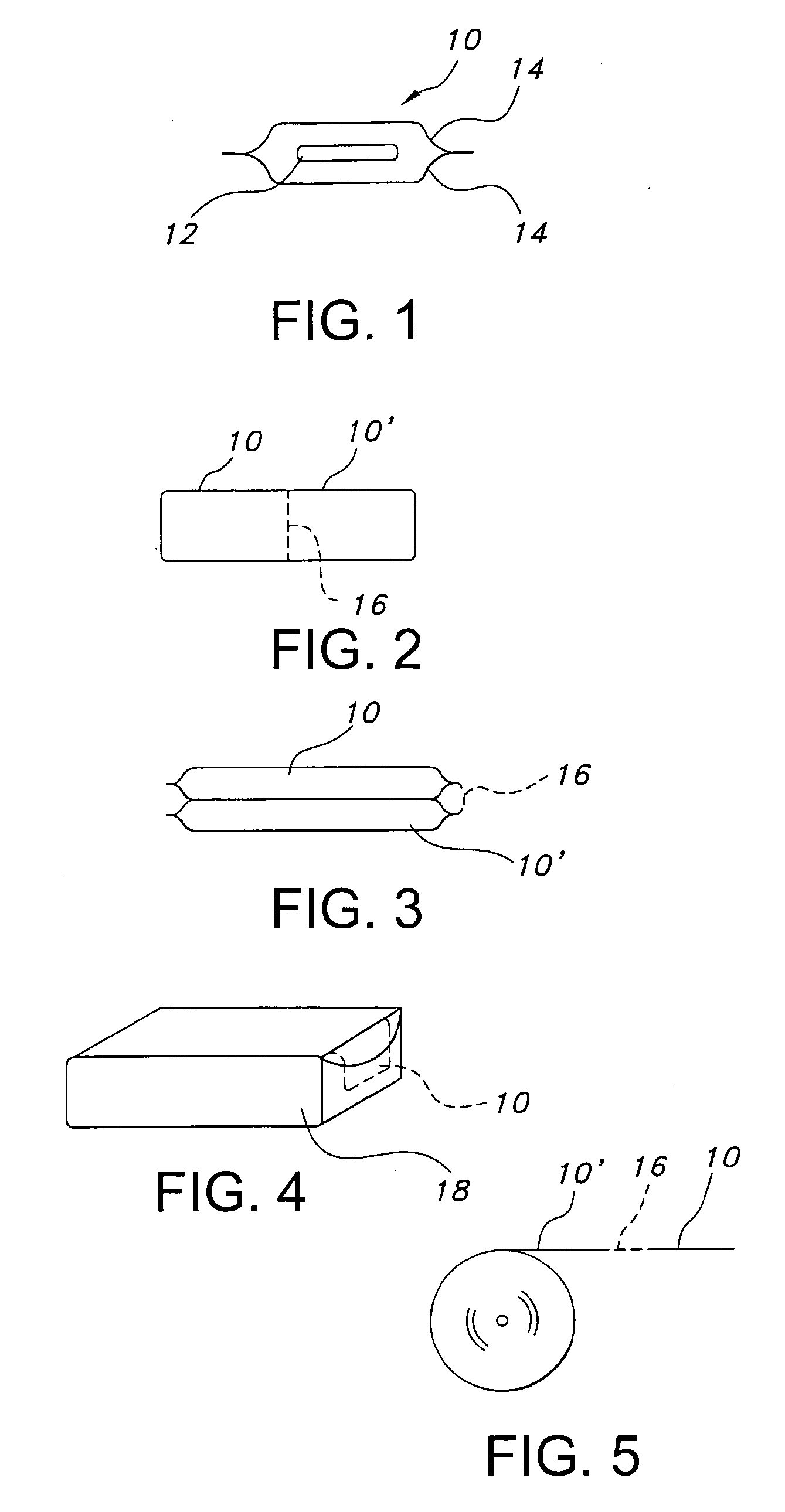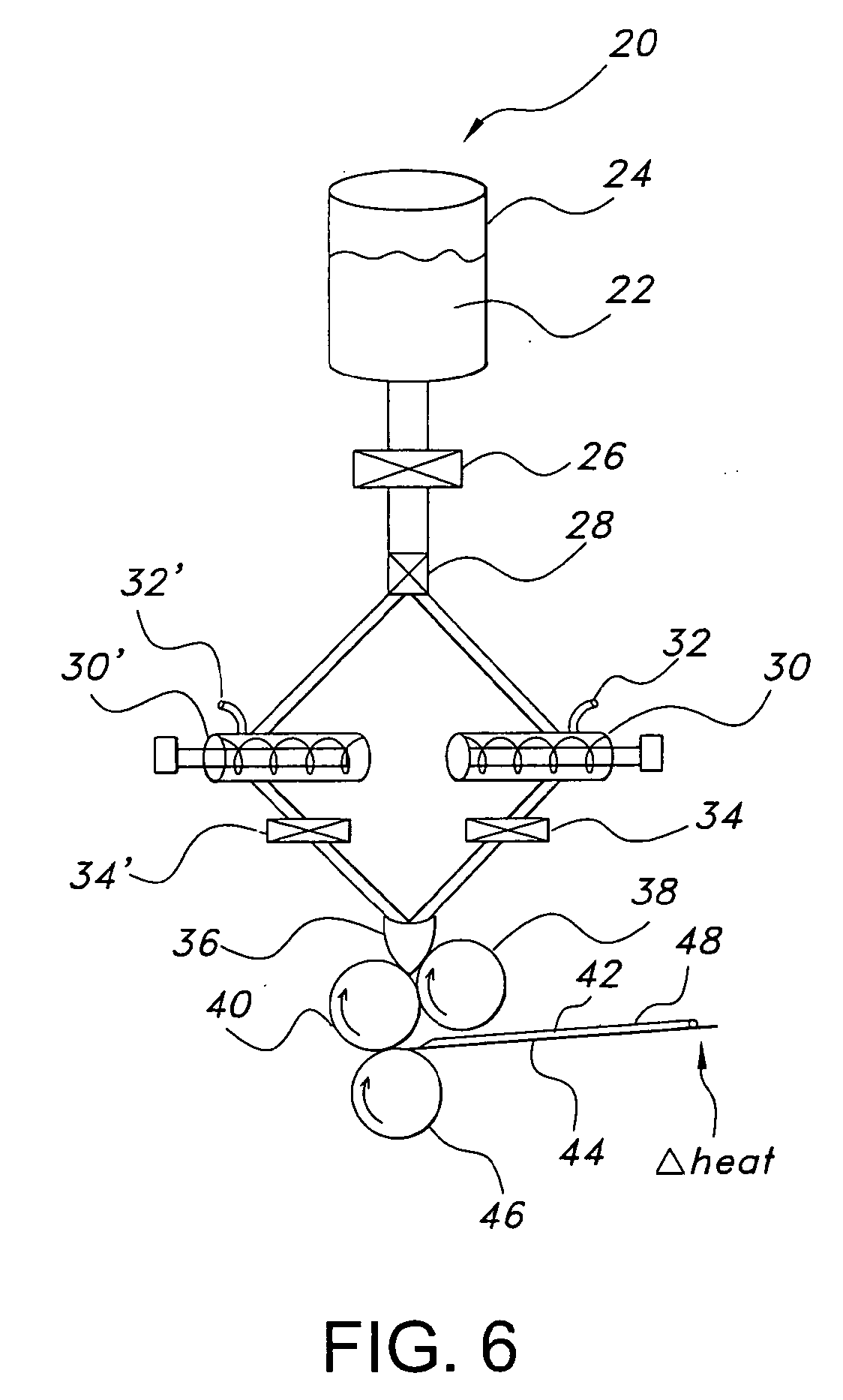Ph modulated films for delivery of actives
a film and active technology, applied in the direction of biocide, drug composition, organic non-active ingredients, etc., can solve the problems of large difference in the amount of active per film, inability to achieve a high degree of accuracy with respect to the amount of active ingredient in the cut film, and inherently non-uniformity, so as to reduce or prevent synerisis
- Summary
- Abstract
- Description
- Claims
- Application Information
AI Technical Summary
Benefits of technology
Problems solved by technology
Method used
Image
Examples
example 1
Incorporation of Citric Acid into a HPMC / PEO Film Base
[0216]The present example is directed to the incorporation of an acidic formulation into a hydroxypropylmethyl cellulose / PEO (80 / 20) film base. The film may be used alone or with another water soluble film if desired. The citric acid may be representative of an active ingredient that can be found in cosmetic or cleaning compositions. Alternatively, the citric acid may be used to modulate the pH of other components contained in the same film or a separate water soluble film. Citric acid is a chemically weak acid. In this example, the citric acid is combined with HPMC / PEO (neutral polymers) in the absence of a buffer system. Therefore, in the present example, the overall system is acidic. The resulting film was found to be useful as a dissolvable film for delivery of an acidic active (25% solids, by weight). The components are shown below in Table A.
TABLE AComponentsWt (g)Polyethylene oxide WSR-N801.24Hydroxypropylmethyl cellulose ...
example 2
Incorporation of Citric Acid / Sodium Citrate into an HPMC / PEO Film Base
[0223]The present example is directed to the incorporation of both an acidic compound (citric acid) and a buffer system (sodium citrate) into a hydroxypropylmethyl cellulose / polyethylene oxide (80 / 20) film base. Approximately 50 mg citric acid and 50 mg of sodium citrate were incorporated into a 215 mg film strip, along with the neutral polymers, resulting in a neutral system (25 wt % solids). The components of the film are shown below in Table C.
TABLE CComponentsWt (g)Polyethylene oxide WSR-N801.32Hydroxypropylmethyl cellulose5.30Sodium citrate2.91Citric acid2.91Sorbitan monooleate NF (Span 80)0.06
[0224]Sorbitan monooleate from Table C and 37.5 g of distilled water were added to a Degussa 1100 bowl. Then, a blend of the polyethylene oxide and hydroxypropylmethyl cellulose was added to the bowl. The combination of components was mixed using the Degussa Dental Multivac Compact under the conditions described in Tabl...
example 3
Incorporation of Citric Acid and Sodium Citrate into a PEO / Propylene Glycol Alginate Film Base
[0227]The present example is directed to the incorporation of citric acid, and its complementary base, sodium citrate into a polyethylene oxide / propylene glycol alginate (98 / 2) film base for use as a dissolvable film (34% solids, by weight). The film further included Tween 80. The components of the film are shown below in Table E. In some embodiments, the film may be used in conjunction with a second water soluble film.
TABLE EComponentsWt (g)Polyethylene oxide WSR-N808.5Colloid 6022 (propylene glycol alginate)0.17Citric Acid3.61Sodium citrate4.52Tween 80 NF spectrum0.362Available from TIC Gums, Belcamp, MD
[0228]The Tween 80 was combined with 33 g distilled water in a Degussa 1100 bowl. Then, a blend of the polyethylene oxide, citric acid and sodium citrate was added to the bowl. The combination of components was mixed using the Degussa Dental Multivac Compact under the conditions set forth ...
PUM
| Property | Measurement | Unit |
|---|---|---|
| pH | aaaaa | aaaaa |
| surface area | aaaaa | aaaaa |
| water soluble | aaaaa | aaaaa |
Abstract
Description
Claims
Application Information
 Login to View More
Login to View More - R&D
- Intellectual Property
- Life Sciences
- Materials
- Tech Scout
- Unparalleled Data Quality
- Higher Quality Content
- 60% Fewer Hallucinations
Browse by: Latest US Patents, China's latest patents, Technical Efficacy Thesaurus, Application Domain, Technology Topic, Popular Technical Reports.
© 2025 PatSnap. All rights reserved.Legal|Privacy policy|Modern Slavery Act Transparency Statement|Sitemap|About US| Contact US: help@patsnap.com



